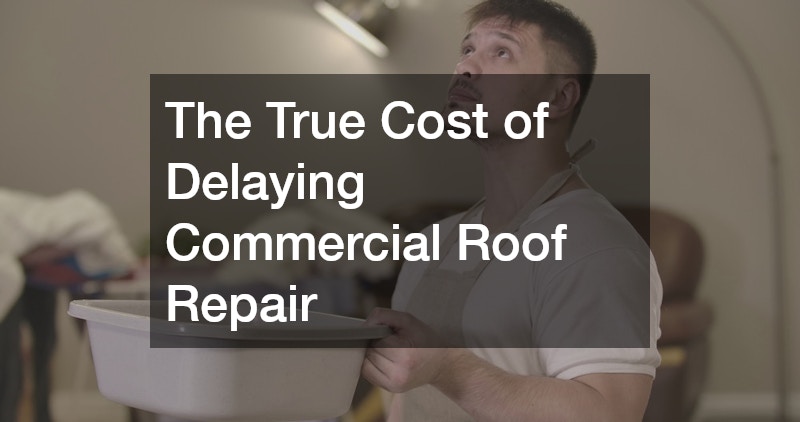In the world of property management, commercial roofs often stand unappreciated until they become problematic. Many business owners treat roof issues as secondary concerns, often delaying necessary repairs due to budgetary constraints or a lack of immediate impact on daily operations. However, the true cost of delaying commercial roof repair extends far beyond initial financial savings and can have significant long-term repercussions.
The Financial Impact of Roof Neglect
While delaying commercial roof repair may seem like an immediate cost-cutting measure, it often results in higher expenses down the line. Initial small leaks or minor damage can quickly escalate into significant structural problems that require extensive repairs.
According to industry experts, what starts as a minor issue can potentially increase repair costs exponentially within just a few months.
Moreover, an unrepaired roof can lead to increased energy costs. A compromised roof system may lack the insulation and sealing necessary to regulate building temperatures, forcing HVAC systems to work harder, thus inflating energy bills. Consequently, businesses are faced with rising overheads due to unnecessary energy consumption.
Additionally, ignoring roof issues can impact insurance claims and premiums. Insurance providers may refuse claims on damages resulting from neglect or require higher premiums due to perceived risks. Business owners ultimately end up paying more than necessary due to these increased liabilities and additional strain on financial resources.
The Safety Risks for Occupants and Property
Delaying commercial roof repair can pose significant safety hazards for occupants and the property itself. Water infiltration, resulting from a damaged roof, can lead to mold and mildew growth, posing serious health risks to individuals working in the building. In some cases, prolonged exposure to mold can trigger allergies and respiratory issues among staff, ultimately reducing workplace productivity.
Structural deterioration caused by persistent roof leaks can lead to dangerous physical hazards such as ceiling collapses or falling debris. These risks are not only immediate threats to safety but can also result in costly lawsuits and settlements. A proactive roof repair strategy helps mitigate these risks, providing a safer environment for employees and clients alike.
Moreover, the presence of water damage can contribute to electrical failures and fire hazards. Insulated cables and electrical panels exposed to moisture can create short circuits, increasing the likelihood of electrical fires. Addressing roof repair needs promptly minimizes these risks and contributes to a stable and secure operational environment.
The Impact on Business Operations and Reputation
Beyond financial and safety concerns, delayed roof repairs can disrupt normal business operations. Leaks and damage can lead to the closure of parts or all of a building, interrupting business activities and resulting in lost revenue. The operational disruptions can be costly, especially for businesses that rely on their premises to generate income, such as retail outlets or service providers.
Moreover, the presence of ongoing leaks or structural damage can project a poor image to clients and consumers. Customers frequenting a business might perceive neglect if they notice damages like water stains or sagging ceilings. Such perceptions can tarnish the reputation of a brand and potentially impact customer retention and acquisition negatively.
Furthermore, potential investors and partners might view such neglect as indicative of poor management practices. Businesses with a reputation for overlooking essential maintenance might find it challenging to secure future investments or partnerships. By maintaining and repairing commercial roofs timely, companies ensure smooth operations and preserve their reputation in the competitive marketplace.
The Importance of Proactive Roof Management
The significance of proactive roof management cannot be overstated, especially in the context of commercial properties. Implementing regular roof inspections and maintenance schedules can prevent minor issues from escalating and ensure that repairs are conducted when needed. A proactive approach minimizes unexpected disruptions and secures the integrity of the building envelope.
Regular maintenance not only extends the lifespan of a roof but also enhances its performance. A well-maintained roof contributes to improved energy efficiency, which reduces utility expenses and supports a company’s sustainability goals. The long-term financial savings and operational benefits outweigh the relatively minimal cost of regular inspections and timely repairs.
While the temptation to delay roof repairs for cost savings may be strong, the true cost of such delays often outweighs the perceived benefits. Business owners who prioritize timely commercial roof repairs stand to gain significantly in terms of operational efficiency, financial savings, and improved employee and customer safety. The wisdom of addressing commercial roof repair needs without delay is clear, grounding businesses in sustainable practices that promise ongoing security and success.



